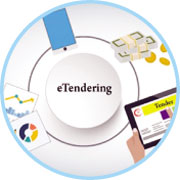 Although the interim government is burdened with an enormous job load, there is hardly any scope to skip some of the key priorities. Few of these, though time-consuming, may be initiated with the objective of what has become a buzzword since the government assumed office-reform.
Although the interim government is burdened with an enormous job load, there is hardly any scope to skip some of the key priorities. Few of these, though time-consuming, may be initiated with the objective of what has become a buzzword since the government assumed office-reform.
Public tendering is one area that no doubt demands an overhaul. The need cannot be overemphasised as the practices bred by traditional tendering have seen the spread of unabated wrongdoings in public procurement and development activities for decades. There were attempts to improve the system in the past but to no practical and useful purpose. The only way to do away with the system is e-tendering.
The rise of the internet, digital connectivity, and the widespread adoption of e-commerce models in the private sector have placed pressure on governments worldwide to modernise. These digital advancements have reshaped not only the private sector but also the expectations from public sector institutions. Hierarchical, bureaucratic models are becoming outdated, replaced by more dynamic, competitive, and knowledge-driven systems. In response, many governments, even in less developed countries, have embraced e-procurement and e-tendering, recognising the potential for these technologies to streamline operations and improve governance.
E-tendering offers a host of benefits. First and foremost, it is a highly efficient tool that simplifies much of the work associated with bidding and post-bidding stages. Traditional tendering processes are often cumbersome and time-consuming, but e-tendering automates these processes, making them faster and more accessible. Moreover, e-tendering enhances transparency-a critical goal for ensuring credible governance. By utilising online platforms, everything from pre-qualification questionnaires to negotiation and award processes can be conducted in a secure, user-friendly environment. This accessibility opens the door for more potential bidders, fostering a more competitive bidding process and minimising the scope for corruption.
Some of the most notable advantages of e-tendering include the reduction of the overall length of the tendering process, lower costs, greater consistency, improved operational efficiency, and enhanced communication among all parties involved. These benefits have been demonstrated in numerous countries that have adopted e-tendering systems. As a result, e-tendering has become a proven method for making public procurement more efficient, transparent, and fair.
In Bangladesh, the idea of e-tendering has been discussed for some time, but progress has been slow, and no significant outcome has been achieved yet. In 2004, with assistance from the World Bank, the government developed an e-government procurement (e-GP) website as an initial attempt to invite bids through a digital portal. The website was designed for state-owned agencies to post their tenders, marking a small step towards digital procurement. Later, the "Government Procurement (e-GP) Guidelines" were introduced as part of the Public Procurement Rules (PPR) of 2008, making the e-GP system compulsory for all public procurement of goods, services, and works. However, despite these efforts, response has been minimal, and the system has not gained the traction it was meant for.
There are several reasons for the lack of progress. One major obstacle is the resistance from government officials who are accustomed to traditional, manual tendering processes. These officials perceive e-tendering as a complex and unfamiliar system, despite its potential to simplify their work. More concerning, however, is that the current manual system provides a "comfort zone" for certain vested interests. The lack of transparency in the traditional tendering process creates opportunities for corruption and manipulation, benefiting individuals who exploit the system to their advantage.
E-tendering, on the other hand, is recognised as an efficient method for analysing and sorting bids because of its inherent transparency. Experts believe that introduction of e-tendering could reduce corruption in public procurement by more than 50 per cent. Public procurement has long been a breeding ground for corruption in the country, with bribery and kickbacks becoming a common practice. By introducing a transparent, digital tendering system, these practices could be significantly curtailed. It is worth noting that one reason for which successive governments may have hesitated to modernise the tendering system is that the manual process provides opportunities for political allies to manipulate bids and contracts, often at the expense of the quality of goods and services procured.
To truly modernise the public procurement process, the government must embrace the digital transformation of its tendering system. E-tendering is a key area of reform that has the potential to not only ease the workload of the authorities but also significantly improve governance.
However, achieving this reform will require political will. Without a strong commitment from the government to push through the changes, the current system will remain entrenched, and the opportunity to improve governance through digitisation will be lost. The government must prioritise the implementation of e-tendering and take decisive action to overcome the inertia and resistance that have so far hindered progress.
wasiahmed.bd@gmail.com
© 2025 - All Rights with The Financial Express
